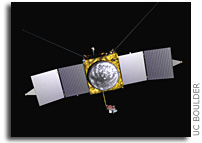NASA’s MAVEN Mission: Where Did the Water on Mars Go?

The planet Mars, with its rust red countenance and barren character, presents itself as an object of mystery and intrigue. It is also a catalyst for ongoing scientific inquiry.
Previous space probes have revealed valleys, channels and ocean beds marking the Martian surface, suggesting the presence of abundant flowing water in earlier times.
Such tantalizing clues give way to the obvious question: where did the water go? Scientists believe it may have something to do with the planet’s thin atmosphere. The atmosphere is too thin today to support liquid water on the surface, but that elicits another query; what led to Mars’ atmospheric depletion?
Such questions are at the heart of the next Mars space probe developed by Lockheed Martin and now being prepped for launch at NASA’s Kennedy Space Center in Florida – the Mars Atmosphere and Volatile EvolutioN mission, or MAVEN.
Scheduled to launch from Cape Canaveral, Fla., aboard a United Launch Alliance Atlas V-401 rocket during a three-week window that opens Nov. 18, MAVEN represents the first spacecraft mission dedicated to exploring Mars’ upper atmosphere.
MAVEN will seek to gauge how solar activity contributes to atmospheric loss and the role that escape of gas from the atmosphere into space has played over time. This information will help scientists gain insight into the history of the planet’s atmosphere and climate, liquid water and planetary habitability for microbial life.
Lockheed Martin shipped MAVEN to Kennedy on Aug. 2 aboard a C-17 transport aircraft that took off from Buckley Air Force Base in Aurora, Colo. Lockheed Martin Space Systems designed, assembled and tested the spacecraft at its Waterton facility near Denver.
The one-year assembly and testing period prior to shipment ran very smoothly, according to Guy Beutelschies, Lockheed Martin MAVEN program manager.
“MAVEN is a good example of what is possible when you get a mission that matches well to the design and resources and when you put a team on the job whose members are used to working together,” said Beutelschies. “We enjoyed a relatively smooth development. We’re on schedule, on budget and right where we want to be on our journey to the launch pad. The team is working very few issues right now; we’re just executing to our plan.”
Lockheed Martin engineers and technicians who were deployed to Florida with the spacecraft ran MAVEN through its final processing in preparation for launch. Activities included re-installing the high-gain antenna, installing flight batteries, software testing, payload deployment tests, a final solar array deployment and illumination test, spin balancing, and propellant loading.
Once launched, MAVEN will embark on a 10-month journey to Mars and will enter orbit around the planet in September 2014. It will then spend five weeks getting into the final science-mapping orbit, performing payload related deployments, and configuring all systems for the science phase. MAVEN will then begin a one-Earth-year primary science mission.
MAVEN’s instruments will permit scientists to study the upper atmosphere and ionosphere, pinpoint the rate of gas loss to space currently and calculate backward in time to determine the total loss to space through time. MAVEN will boast three instrument packages, including:
- The Particles and Fields Package, integrated by the University of California at Berkeley’s Space Sciences Laboratory, contains six instruments that will characterize the Mars solar wind and ionosphere. Three of the instruments were built by the Cal-Berkeley lab, one was built jointly with the Centre d’Etude Spatiale des Rayonnements (CESR) in France, one was built jointly with the University of Colorado at Boulder’s Laboratory for Atmospheric and Space Physics (CU/LASP), and the Magnetometer was built by NASA’s Goddard Space Flight Center in Greenbelt, Md.
- The Remote Sensing Package, built by CU/LASP, will measure global aspects of the upper atmosphere and ionosphere.
- The Neutral Gas and Ion Mass Spectrometer, built by NASA Goddard, will determine the composition and isotopes of neutrals and ions.
MAVEN’s Principal Investigator is Dr. Bruce Jakosky from the University of Colorado at Boulder, and NASA Goddard manages the project.
Heritage of both hardware and people played a big role in making MAVEN assembly and testing successful. Lockheed Martin capitalized on design knowledge from previous Mars orbiters to develop MAVEN.
“Lockheed Martin is fortunate to have participated on all NASA missions to Mars over the last 40 years, so we had lots to build on,” said Beutelschies. “The Mars Reconnaissance Orbiter (MRO) was our starting point for the design and hardware. When you look at MAVEN, its structures and subsystems, you can trace the lineage to MRO.” The avionics and software are based on updated versions that flew on the recent Juno mission to Jupiter.
For Beutelschies, the heritage he really likes to discuss is the people involved in MAVEN, who brought to the effort valuable experience, having worked previous Mars orbiters.
“We have people experienced with designs, processes and procedures we used on a long line of interplanetary spacecraft,” said Beutelschies. “We have people who have worked half a dozen interplanetary missions. We have a keen dynamic culture and are used to working with each other and with the hardware and software.”
Along with the hardware and people experience, strong customer relations proved to be another key factor in enabling a strong production and test regime, according to Beutelschies.
“We’ve had an extremely good working relationship with the customer; they treat us as a partner, and they recognize the experience we bring to the game,” said Beutelschies. “In turn, we seek to be as responsive as possible to the customers and scientists. A lot of the smoothness of MAVEN’s production and testing is because of that great relationship we enjoy.”









